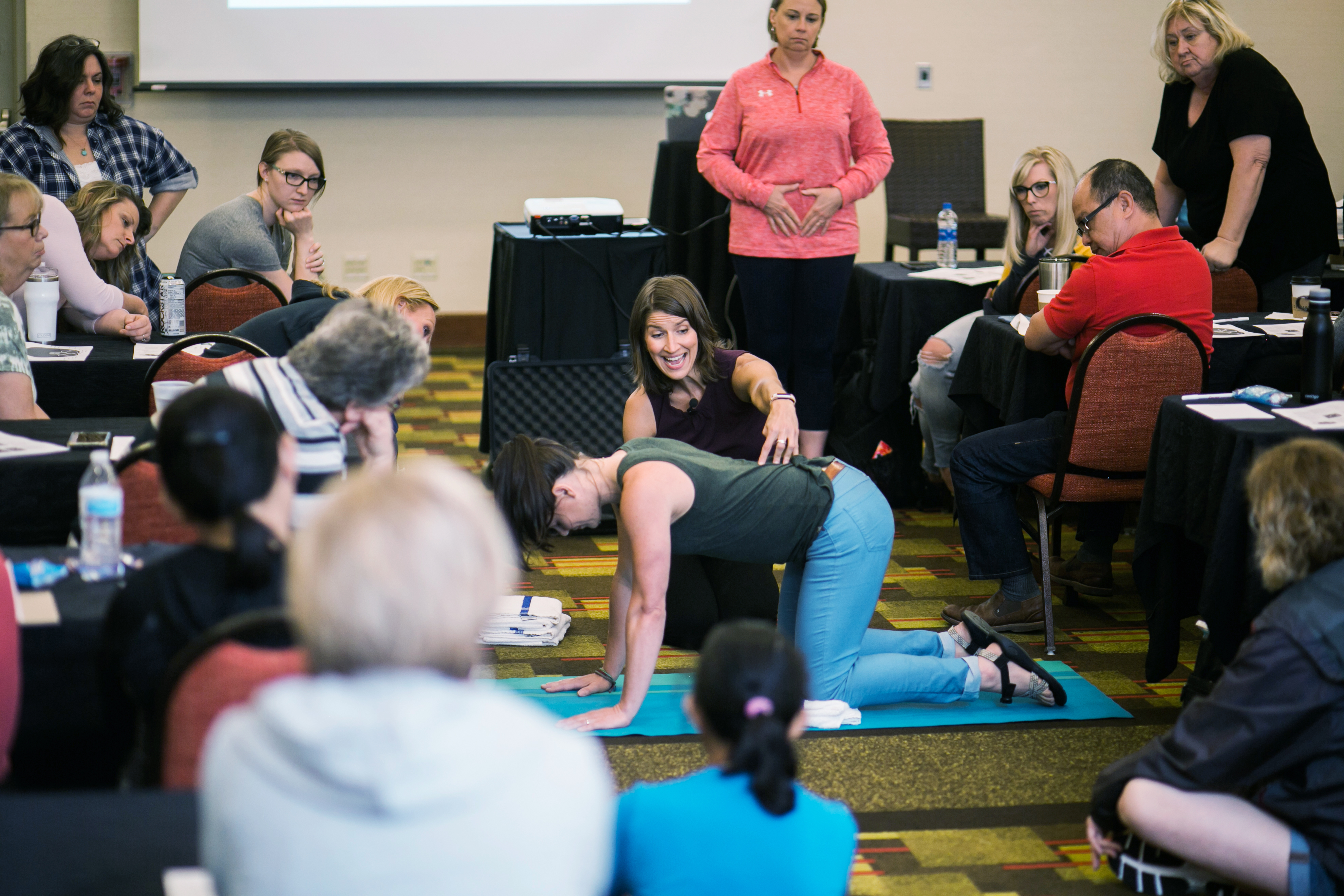Yoga for Every Body

By: Dr. Catherine Lewan, PT, DPT, C-IAYT, RYT (www.catherinelewan.com)
If you have ever wondered, “Can I really do yoga with my patients?” the answer is YES.
It just might not look like the typical American-ized, more-is-better, extreme-booty-toning, hot yoga performed in 95-105 degree Fahrenheit room, nor should it.
The Yoga Sutras, often considered the primary text of yogic philosophy, have very little to say about the physical postures of yoga practice. Rather, the focus is on underlying principles that include concentration, moderation, and integrity that provide a solid foundation for the use of yoga in rehabilitation.
The instructions provided by the Sutras regarding yoga postures, unlike some of the contortions that often visually represent yoga in our society, are refreshingly simple.
Sutra 2.46 describes the physical postures of yoga as a practice of steadiness and ease. That’s it. No contortion required– in fact, if you are straining to get into a pose, it might not even be considered yoga.
The true purpose of yoga is to “calm the thought waves” that create an agitated, anxious, and distracted state, which may benefit anyone dealing with the stress of a health crisis or struggling to make healthy behavior change.
While reviewing the literature for the course Yoga and Pilates for Older Adults that I developed for Summit Professional Education, I was pleasantly surprised to find a wealth of evidence that supports the use of yoga to improve outcomes for patients and therapists alike.
Evidence consistently shows that yoga improves quality of life, physical function, and pain levels for patients ranging from pediatrics to geriatrics, and eases symptoms for people living with Parkinson’s Disease, cancer, anxiety, musculoskeletal conditions, osteoarthritis, chronic fatigue/fibromyalgia, chronic pain, pelvic floor disorders, dementia and more.
Yoga techniques like breathing, imagery, and body awareness can be applied to many scenarios, fostering an environment that is conducive to rehabilitation. Compared to a similar stretch and strengthen intervention, older adults who participated in a yoga-based intervention had significantly improved working memory and mental flexibility (Gothe et al. 2014,) executive functions that are key when asking our patients to stick to a home exercise program or consider healthier behaviors.
Having yogic tools in your clinical toolbox provides evidence-informed options for the difficult situations that we face as rehab specialists. Studies have shown promising results for healthcare practitioners who practice yoga, with improved self-care behaviors and decreased markers of burnout compared to control groups.
I invite you to check out the links below to see if your patients might benefit from yoga… or simply imagine the ways they might benefit from a therapist who is more nourished and present, fresh with new treatment ideas and perspective. I hope to see you on the mat or in a course soon!
References:
Oka T, Wakita H, Kimura K. Development of a recumbent isometric yoga program for patients with severe chronic fatigue syndrome/myalgic encephalomyelitis: A pilot study to assess feasibility and efficacy. Biopsychosoc Med. 2017 Mar 3;11:5. doi: 10.1186/s13030-017-0090-z. eCollection 2017.
Anderson JG, Rogers CE, Bossen A, Testad I, Rose KM. Mind-Body Therapies in Individuals With Dementia: An Integrative Review. Res Gerontol Nurs. 2017 Nov 1;10(6):288-296. doi: 10.3928/19404921-20170928-01. Epub 2017 Oct 6. Review.
Birdee GS, Yeh GY, Wayne PM, Phillips RS, Davis RB, Gardiner P.Clinical Applications of Yoga for the Pediatric Population: A Systematic Review. Academic pediatrics. 2009 Jul–Aug; 9(4): 212-220.e1-9
Büssing A, Ostermann T, Lüdtke R, Michalsen A.Effects of yoga interventions on pain and pain-associated disability: a meta-analysis. J Pain. 2012 Jan;13(1):1-9. doi: 10.1016/j.jpain.2011.10.001. Epub 2011 Dec 16. Review.
Danhauer SC, Addington EL, Cohen L, Sohl SJ, Van Puymbroeck M, Albinati NK, Culos-Reed SN. Yoga for symptom management in oncology: A review of the evidence base and future directions for research. Cancer. 2019 Jun 15;125(12):1979-1989. doi: 10.1002/cncr.31979. Epub 2019 Apr 1. Review.
Huang AJ, Chesney M, Lisha N, Vittinghoff E, Schembri M, Pawlowsky S, Hsu A, Subak L.A group-based yoga program for urinary incontinence in ambulatory women: feasibility, tolerability, and change in incontinence frequency over 3 months in a single-center randomized trial. Am J Obstet Gynecol. 2019 Jan;220(1):87.e1-87.e13. doi: 10.1016/j.ajog.2018.10.031. Epub 2018 Oct 26.
Sharma NK, Robbins K, Wagner K, Colgrove YM.A randomized controlled pilot study of the therapeutic effects of yoga in people with Parkinson’s disease. Int J Yoga. 2015 Jan;8(1):74-9. doi: 10.4103/0973-6131.146070.
Lauche R, Hunter DJ, Adams J, Cramer H.Yoga for Osteoarthritis: a Systematic Review and Meta-analysis. Curr Rheumatol Rep. 2019 Jul 23;21(9):47. doi: 10.1007/s11926-019-0846-5. Review.
Green E, Huynh A, Broussard L, Zunker B, Matthews J, Hilton CL, Aranha K.Systematic Review of Yoga and Balance: Effect on Adults With Neuromuscular Impairment. Am J Occup Ther. 2019 Jan/Feb;73(1):7301205150p1-7301205150p11. doi: 10.5014/ajot.2019.028944.
Ward L, Stebbings S, Cherkin D, Baxter GD. Yoga for functional ability, pain and psychosocial outcomes in musculoskeletal conditions: a systematic review and meta-analysis. Musculoskeletal Care. 2013 Dec;11(4):203-17. doi: 10.1002/msc.1042. Epub 2013 Jan 9. Review.
Alexander GK, Rollins K, Walker D, Wong L, Pennings J. Yoga for Self-Care and Burnout Prevention Among Nurses. Workplace Health Saf. 2015 Oct;63(10):462-70; quiz 471. doi: 10.1177/2165079915596102.
Gothe NP, Kramer AF, McAuley E. The effects of an 8-week Hatha yoga intervention on executive function in older adults.J Gerontol A Biol Sci Med Sci. 2014 Sep;69(9):1109-16. doi: 10.1093/gerona/glu095. Epub 2014 Jul 14.
